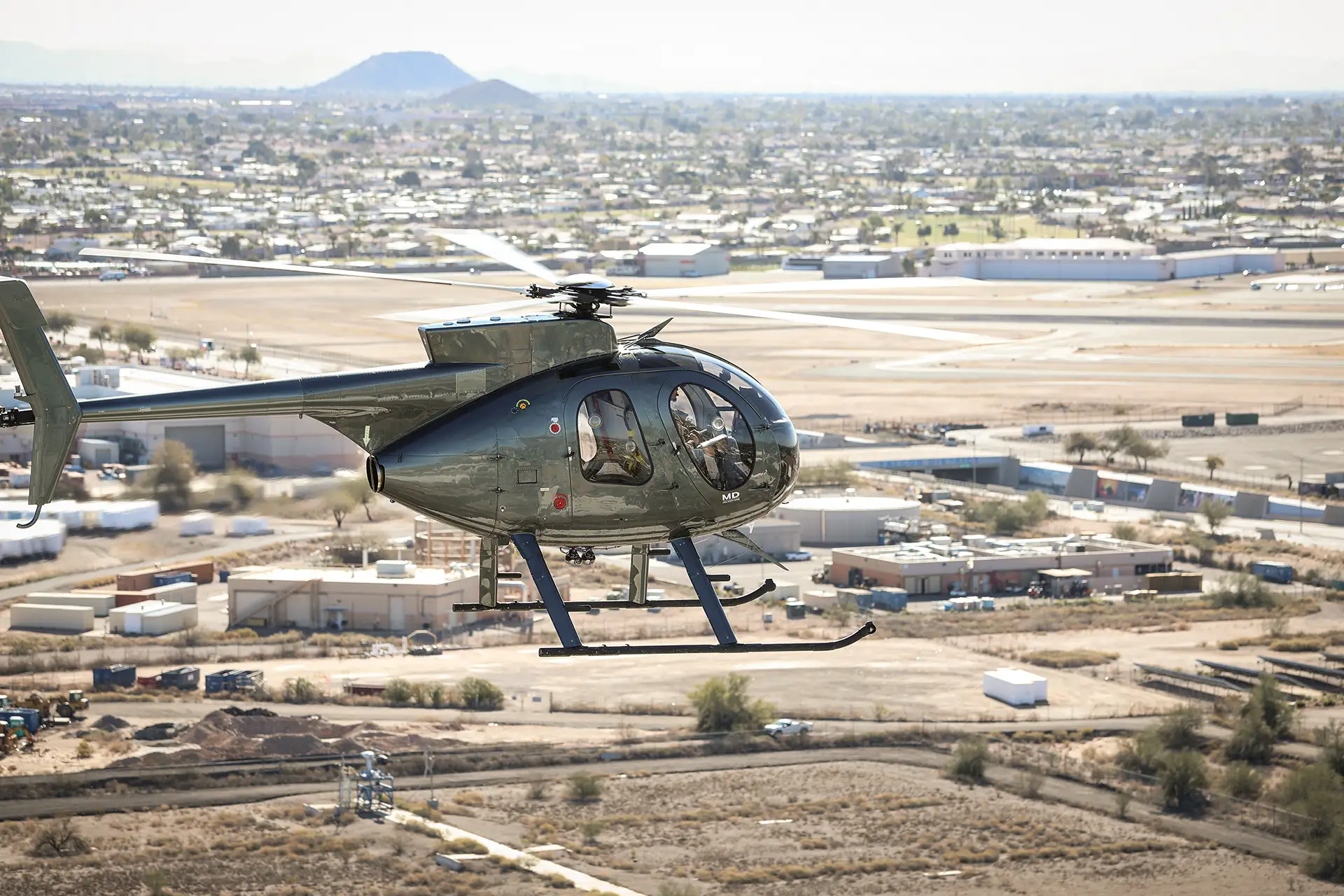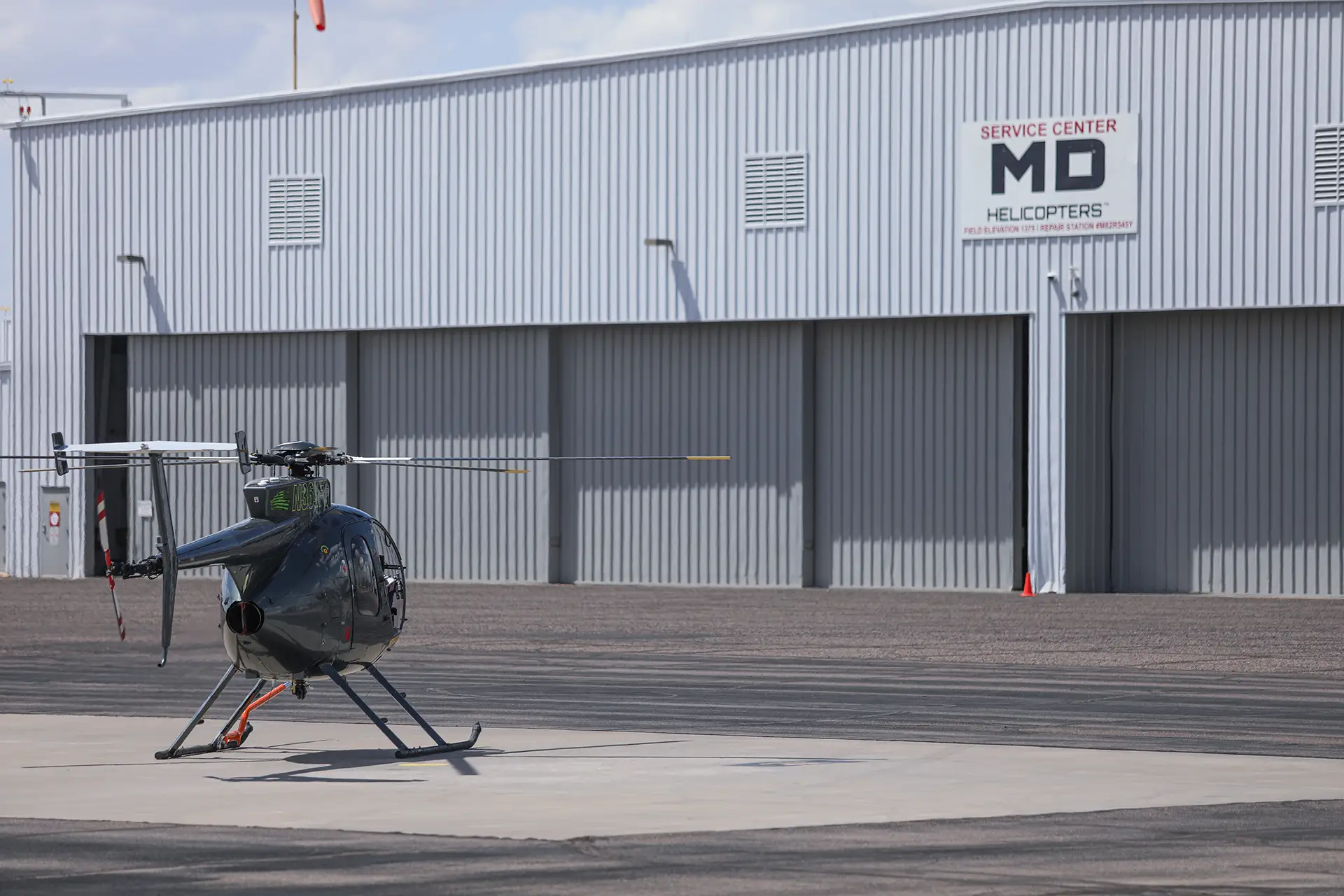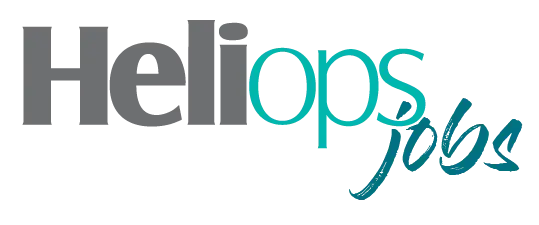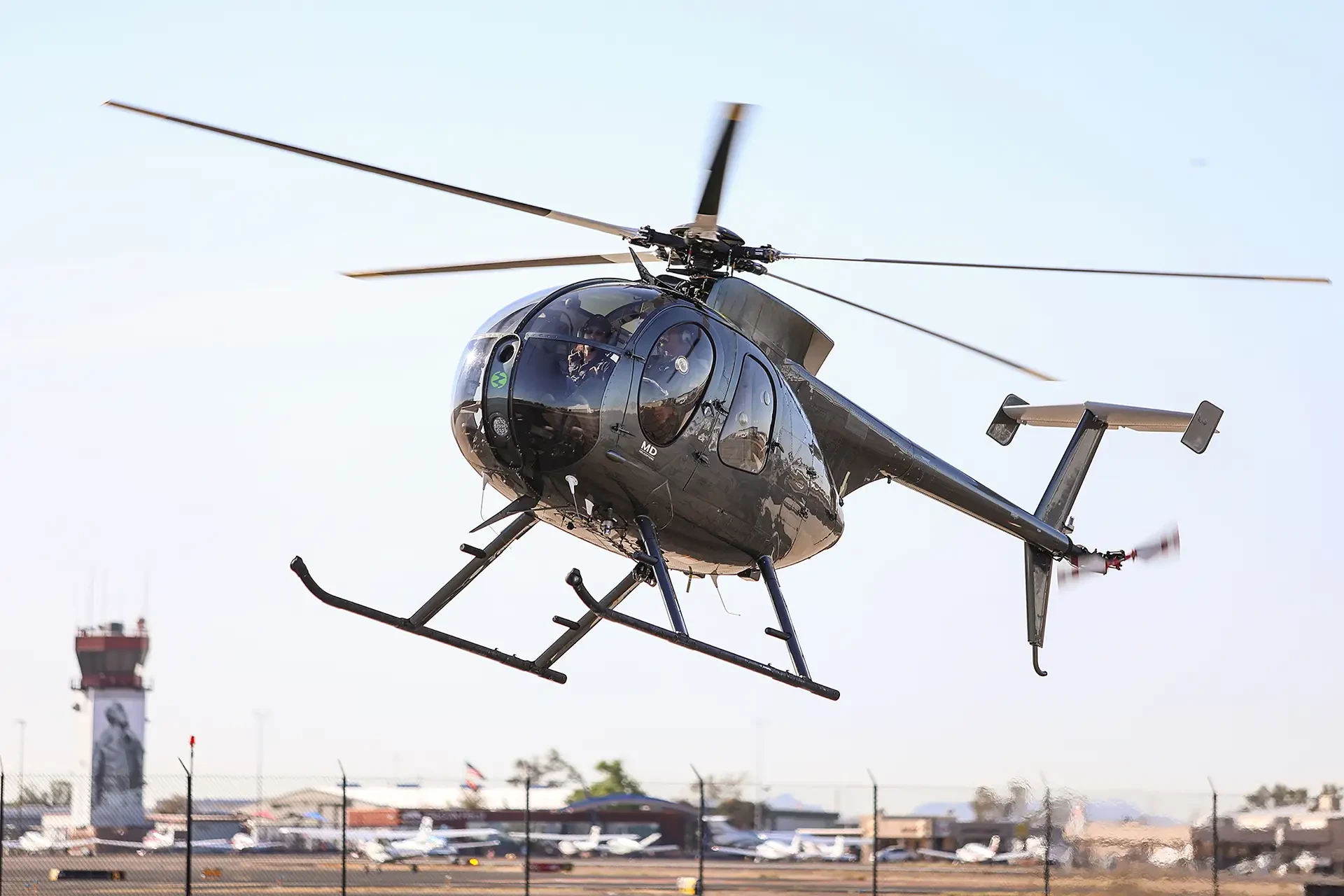As MD Helicopters undergoes yet another reformation, Paul Kennard explores MD’s philosophy and plans
MD Helicopters (MDH) has a long and established 'brand' in the light helicopter market. Since its inception as Hughes Helicopters, the buyout by McDonnell Douglas and subsequent spin-out as a separate commercial helicopter company after the merger with aviation giant Boeing, the company's 'signature' product has been the 500 and 530 series. Other products have come and gone. The Hughes YAH-64 Apache was the product that piqued the attention of both McDonnell Douglas and Boeing, with the aircraft continuing in production to this day at the facility in Mesa, Arizona, Boeing also retains the rights to the military version of the MD500, the AH-6/MH-6 - best known as the 'Little Bird' flown by the 160th Special Operations Aviation Regiment (SOAR). MD did have a second product line for a number of years, the MD900/902 Explorer, a twin-engined 'NOTAR' (No Tail Rotor) machine designed for the needs of the Law Enforcement and Emergency Medical Services communities. The Explorer's compact dimensions helped with off-site landings in congested urban areas, while its generous rear loading door and cabin made it ideal for loading and then dealing with a patient on a litter. The NOTAR was more resistant to damage than a conventional tail rotor, enabling pilots to squeeze their charges, sometimes, into sites that were technically too small for the aircraft. The large cabin and excellent visibility also made the Explorer popular with Police Air Support Units (ASUs) throughout the world.
Explorer Demise
Why then, it's logical to ask, is the Airbus H135/145 seemingly the 'helicopter of choice' for most ASUs and EMS operators worldwide? The uncomfortable truth is that despite its rugged and practical design and excellent handling qualities, the Explorer developed a reputation for poor logistical support. MD Helicopters seemed incapable of maintaining an integrated supply chain that enabled busy units to rely on their aircraft. The dreaded phrase 'AOG' (Aircraft On Ground) became common when talking about the aircraft. Various cashflow issues at MD Helicopters in the early years of this century meant that the company would often hold little to no stock of spares and was therefore unable to support its customers. Aircraft would spend months 'AOG' awaiting parts, and, over time, that became unacceptable. Some industrious support companies started buying up AOG airframes and reducing them to component parts to help restock their own supply chains, but there were always those 'pinch point' items for which there was no alternative provision. MDH slowly lost the market, and Eurocopter, now Airbus, swiftly moved in. Where once the Explorer was a common sight in the sky, it is now increasingly rare.
It's a shame, I’ve only flown the Explorer once, but it left me with the impression of a sweet-handling aircraft, with excellent visibility, well considered cockpit ergonomics (especially compared to early versions of the H135...on an online forum one pilot dryly observed that a pilot was 'definitely in the room' when the Explorer was designed, but clearly on a long summer vacation when Eurocopter was designing the EC135) and a noticeably brisk climb rate. It was quieter than a conventional helicopter, and, perhaps, a little bit quieter than even a H135.
Throughout the past 25 years of corporate turbulence, the MD500/530 family has kept the brand alive. Now, finally, back on what appears to be a far more solid financial footing, MD seem to be getting their engineering and commercial mojo back. Backed by a consortium of investors including Bardin Hill Investment Partners, MBIA Insurance and MB Global Partners, the new senior leadership teams have brought assurance and focus to a company and a portfolio that has lacked both for much of the past two decades. In decision terms, the Explorer has been put on 'indefinite pause' in terms of production - and, indeed, in conversations I've had with a number of senior MD Helicopters executives over the past few months, the entire product line for the Explorer, including the tooling, would be available for another organisation to purchase and invest in. MD will attempt to maintain 'life support' where viable, but the company is now doubling down on its 'core' model, the MD500/530.
Super 500
I had the opportunity to speak recently to Ryan Weeks, MD's President for the past year. The primary topic of conversation was the 'Super' family of upgrades for the 'D' and 'E' models of the 500/530 family. Ryan, and the rest of the senior team at MDH, have adopted the concept that simply selling new build helicopters is not a viable business model. As Ryan notes, 'New helicopters are expensive, not everyone can afford one...' he points to a global fleet of over 1700 helicopters and breaks them down into broadly three categories. Firstly, owners and operators who are happy with what they've got; the aircraft is fit for purpose, and spares and support are sufficient. At the other end of the scale are both new owners and those with the means to update their fleets with new-build helicopters. MD will be delighted to sell you a brand new MD530F for $3 million - 'walk this way sir...' - but Ryan acknowledges that there's not a large amount of up-front profit from selling a new machine - it's the aftermarket (spares, servicing and upgrades) that is the 'profit engine' for most aircraft manufacturers.
Many years ago, when a student, I did some summer work in the aviation industry, mainly stripping gas turbine engines. One engine I did quite a lot of was the Rolls-Royce Dart turboprop - a very popular engine for civil and military transport aircraft in the 1960s and 70s. I was always amazed that we could buy an airworthy engine, then strip it for 'Yellow Tagged' (i.e. serviceable) parts and make more money than the acquisition cost. As it was explained to me, operators rarely needed a whole engine, and they normally had existing relationships with 'engine shops' for exchanging time-expired engines for freshly overhauled ones, but they often needed the small parts. The engine 'accessories' - the pumps, tubes, meters, driveshafts etc that every engine is 'dressed' with before fitting to the aircraft can fail, or hit a use limit before the core engine, and if they do, a commercial aircraft AOG is costing money for every moment it's not revenue earning - so the profit margin on a part can be attractive.

Aftermarket Support
MDH are now taking the aftermarket much more seriously. Ryan categorised it as the company ‘needs to get healthy on parts' to continue to rehabilitate its reputation. This is the 'middle' of Ryan's three categories. These are the established owner/operators who want to do more with their existing aircraft, but they don't have the means or need to upgrade to a new build 530F, and, historically, have harboured doubts about MDH's ability to support their machines. 'We've always offered our customers the option to upgrade their existing D and E machines to an F standard' explained Ryan ' but the catch was you had to ship the aircraft back to our Mesa, Arizona, facility for the work to be done.'. This was inevitably a step too far for a lot of operators. Not only was the upgrade itself expensive, but it also meant losing the aircraft for several months while the work was conducted - often requiring the operator to either conduct the overhaul in an 'off season' (if they had one) or, more usually, swallow the costs of hiring in a replacement machine. There were also the not inconsequential costs of either flying or shipping the aircraft to and from the factory to consider. Additionally, the package of work might leave the operator paying for upgrades they didn't actually need or want. A glass cockpit is one such example; while for some applications a shiny set of Multi-Function Displays (MFDs) are a real advantage, for many utility operators the rugged and simple analogue dials work just fine - and it’s what the pilots are familiar with.
What MD are now proposing, with their 'Super X' initiative, is to enable existing owners and operators of the MD500/530 to pick and choose their upgrades to better match their needs and their budgets, without having to pay for capabilities they neither want nor need. Ryan notes that MD have also learned from the slow uptake of the E-F factory modification; not only can customers now select only those individual or packaged upgrades that they need, but can have them fitted at any one of 35 approved MDH Authorised Service Centres at a time that suits them. The less invasive modifications are quicker than the full E-F program, leading to less downtime on the aircraft and, in turn, less exposure to the risk of having to lease an interim platform. Ryan suggests it’s just 'good business' to listen to customers and, if possible, give them what they want - firstly, they'll continue to spend money with you, and, secondly, it may well stop them looking at the products made by your competitors.
What, then, does the ' à la carte' Super X menu consist of?
One key package, the 'Super D20B' is aimed at giving existing users more payload by increasing the internal Max Gross Weight (MGW) of the aircraft. The aircraft is fitted with 6" longer Main Rotor Blades (MRBs), a complimentary 6" extension to the Tail Rotor Gear Box location, with moulded Tail Boom. The enhancements lift the internal MGW from 3000lbs to 3350lbs - some 10% increase (the external MGW remains at 3850lb for sling load operations). There's no need to change out the engine to achieve the higher MGW at sea level / ISA temperatures but fitting the bigger RR250-C30 engine variant (becoming the 'Super D30) enables to Super D20B to maintain that MGW improvement at high density altitudes - which could be extremely useful for utility operators and for Law Enforcement users in some of the warm and high elevation States. From MDH's published figures, the Hover Ceiling Inside Ground Effect (IGE) at 20C for the 'stock' MD530D is 8000ft, but nearly 14000ft in 'Super D30' configuration with the full suite of mods and C30 engine.
Ryan explained that the modular nature of the upgrades means that customers can fit them sequentially at a convenient time. For example, the full package of 'D to F' upgrades, effectively the Super D20B and Super D30 mods, and a reconditioned C30 engine costs about $700k. However, the TBO between the engine and the MRBs may be unaligned, so there would be no point in replacing the engine early. The airframe and rotor mods are about $350k as a package, roughly 10% of the cost of a new MD530F, but delivering the same MGW at sea level. If you factor in that a 'normal' blade overhaul is routinely between $100-150k then the gap gets even smaller; if a customers' blades are time expired, then the promise of an extra 350lbs of MGW for around $200k additional expenditure and a small amount of extra down time can be very tempting. A reconditioned C30 engine sits at around $300k (hence the $700k 'all in' figure as a starting point). Ryan explained that not every customer needs the bigger engine, but those that do can source it through their own networks for installation at a MDH ASC, or, naturally, MD would be happy to source an engine if required.
In terms of Certification, the Supplementary Type Certificate (STC) for the Super D20B modification is expected in the very near future, hopefully by August this year, with the STC for the C30 engine upgrade to the Super D20B configuration by Christmas. A separate STC for the C30 engine by itself is expected next year. Alongside the airframe and engine packages, MDH are in the process of certifying a new suite of glass cockpits for the aircraft, with STC expected next year.

In conclusion, then, MD Helicopters seems to have finally turned the corner. By rationalising the product line and listening closely to their customers, the new senior management team are moving the company decisively to a firmer footing. By aligning the business model of the organisation better with the operational and cost model needs of their user and operator community, they are charting a course to retain their loyal customers in the long term, offering only the upgrades they need at a time and location suitable to them. The way the helicopter industry works, via word of mouth, a recommendation, there’s every chance that the 1700-odd global fleet that MDH currently supports could well start to grow again - and a healthy MDH would be a good barometer for the health of the industry as a whole.
 HOME
HOME



